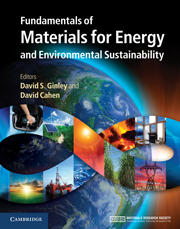Book contents
- Frontmatter
- Contents
- Contributors
- Preface
- Acknowledgments
- Part 1 Energy and the environment: the global landscape
- 1 A primer on climate change
- 2 The global energy landscape and energy security
- 3 Sustainability and energy conversions
- 4 Energy cost of materials: materials for thin-film photovoltaics as an example
- 5 Economics of materials
- 6 Global energy flows
- 7 Global materials flows
- 8 Carbon dioxide capture and sequestration
- Part 2 Nonrenewable energy sources
- Part 3 Renewable energy sources
- Part 4 Transportation
- Part 5 Energy efficiency
- Part 6 Energy storage, high-penetration renewables, and grid stabilization
- Summary
- Appendix A Thermodynamics
- Appendix B Electrochemistry
- Appendix C Units
- Index
- References
1 - A primer on climate change
from Part 1 - Energy and the environment: the global landscape
Published online by Cambridge University Press: 05 June 2012
- Frontmatter
- Contents
- Contributors
- Preface
- Acknowledgments
- Part 1 Energy and the environment: the global landscape
- 1 A primer on climate change
- 2 The global energy landscape and energy security
- 3 Sustainability and energy conversions
- 4 Energy cost of materials: materials for thin-film photovoltaics as an example
- 5 Economics of materials
- 6 Global energy flows
- 7 Global materials flows
- 8 Carbon dioxide capture and sequestration
- Part 2 Nonrenewable energy sources
- Part 3 Renewable energy sources
- Part 4 Transportation
- Part 5 Energy efficiency
- Part 6 Energy storage, high-penetration renewables, and grid stabilization
- Summary
- Appendix A Thermodynamics
- Appendix B Electrochemistry
- Appendix C Units
- Index
- References
Summary
Focus
Despite the Kyoto Protocol and a wealth of good intentions, emissions of greenhouse gases (GHGs) – the primary cause of climate change – have continued to increase, not decrease, in recent years.
We face a global environmental crisis that is expected to include increased temperatures over land and in oceans, rising sea levels, more acidification of the oceans, increased flooding as well as drought, and extinction of many species as a result. The climate–energy crisis could cause major disruptions to ecosystems, the availability of fresh water, farming, economic activity, and global political stability on many levels.
- Type
- Chapter
- Information
- Publisher: Cambridge University PressPrint publication year: 2011

